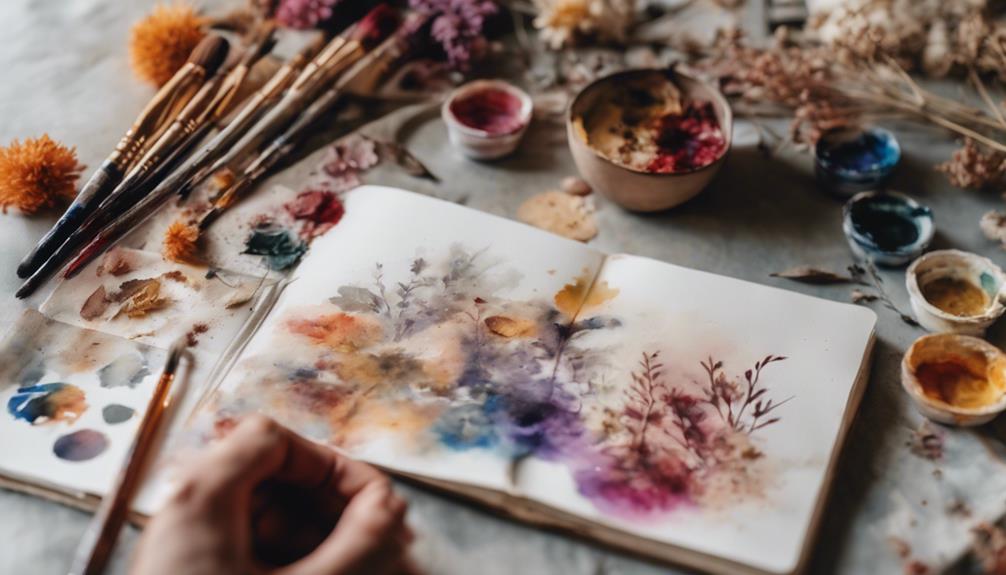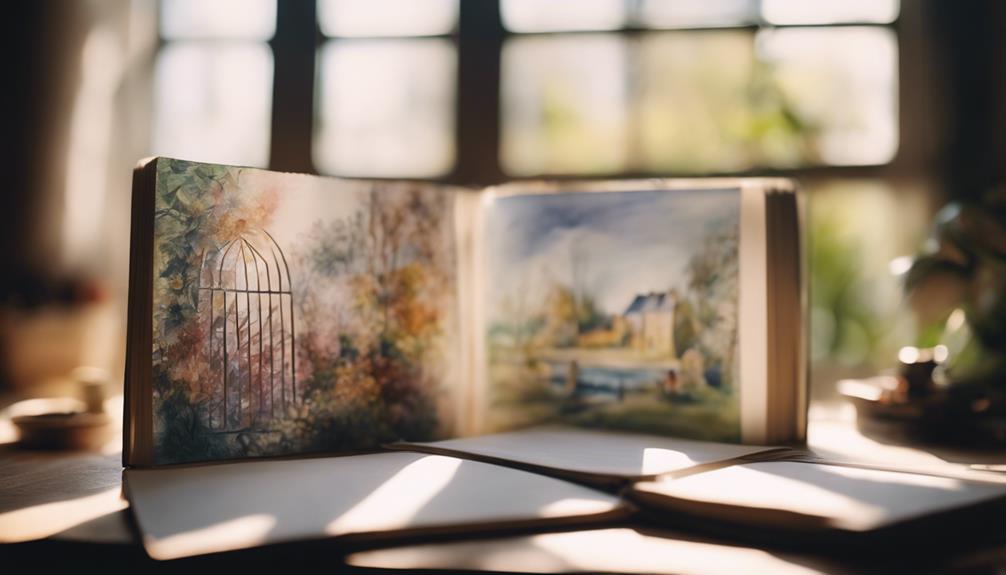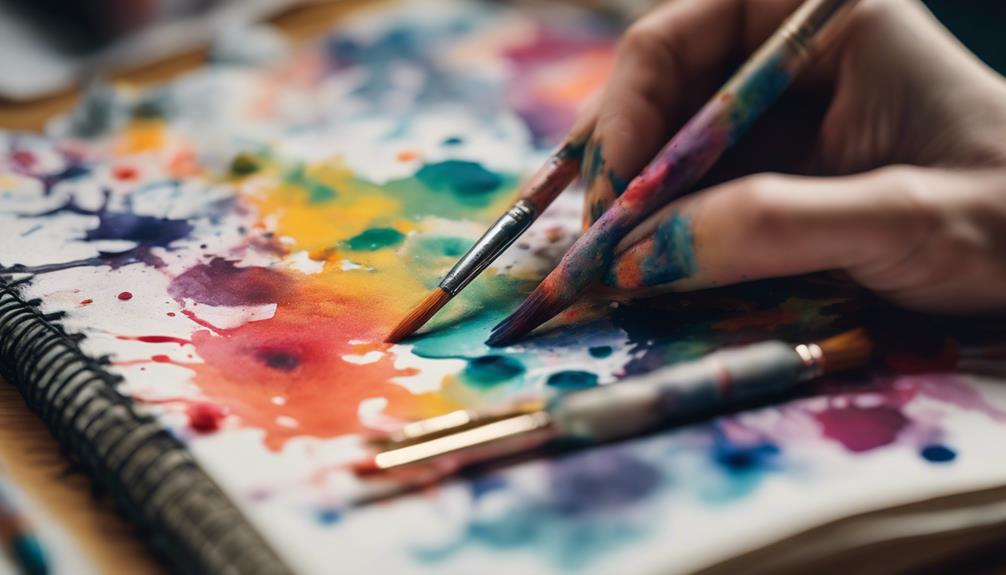Imagine your creativity flowing freely like watercolor on paper, capturing the essence of your surroundings with ease. Have you ever wondered how watercolor sketchbooks can enhance your artistic journey, allowing you to blend colors effortlessly while on the move?
With a few essential tips and techniques, you can elevate your artwork and create stunning pieces wherever you go. Dive into the world of watercolor sketchbooks and unlock the potential of your portable art studio.
Key Takeaways
- Portable watercolor sketchbooks enable creativity anywhere.
- Watercolor supplies enhance artistic vision and creativity.
- Consistent sketchbook practice fosters growth and inspiration.
- Blending colors and techniques enrich watercolor sketchbook content.
Benefits of Watercolor Sketch Books

Watercolor sketchbooks offer a portable and versatile way for artists to capture their surroundings with ease and creativity. The portability advantages of these sketchbooks can't be overstated. They fit easily into your bag or pocket, allowing you to take your art anywhere inspiration strikes. This freedom to create on the go is invaluable, enabling you to seize the moment and translate it onto paper without limitations.
Moreover, watercolor sketchbooks provide a canvas for creative freedom. The blank pages are like an open invitation for experimentation and expression. Whether you want to play with different techniques, mix colors in unique ways, or simply let your imagination flow freely, these sketchbooks accommodate it all. The ability to work spontaneously and without constraints fosters a sense of liberation in your artistic process.
🌊 Discover Endless Fun with Beachcomber Press Puzzle Books! 🌊
Elevate your puzzle game with our captivating collection on Amazon.
Perfect for all ages, our books are packed with unique
challenges that promise hours of entertainment.
Diverse puzzles for every skill level High-quality, engaging content
In essence, watercolor sketchbooks empower you to break free from conventional settings and embrace a more dynamic and fluid approach to art-making. The combination of portability advantages and creative freedom makes them an essential tool for artists seeking to unleash their creativity wherever they go.
Choosing the Right Paper Quality
When selecting a watercolor sketchbook, the quality of the paper is a crucial factor to consider for achieving desired results in your artwork. To make an informed decision, pay attention to the following aspects:
- Paper Textures: Different paper textures, such as hot-pressed, cold-pressed, and rough, can significantly impact your watercolor paintings. Experiment with various textures to find the one that complements your style and technique the best.
- Durability Options: Opt for watercolor sketchbooks with durable paper that can withstand multiple washes and erasures without deteriorating. This ensures that your artwork remains intact over time, preserving your hard work and dedication.
- Weight and Thickness: Consider the weight and thickness of the paper, usually measured in pounds or grams per square meter (GSM). Heavier paper tends to handle watercolor washes better and prevents buckling.
- Acid-Free Paper: Choose sketchbooks with acid-free paper to prevent yellowing and deterioration over time, ensuring the longevity of your watercolor artworks. Acid-free paper also helps maintain the vibrancy of your colors for years to come.
Essential Watercolor Supplies for Sketching

Considering the importance of selecting the right paper quality for your watercolor sketchbook, now let's explore the essential supplies you need for sketching with watercolors.
When opting for portable options, compact watercolor sets are ideal for on-the-go sketching. Look for sets that offer a variety of colors to enhance your creations. A water brush is a convenient tool for blending and painting without the need for a separate water container. This liberating tool simplifies your setup and allows for more flexibility in your artistic process.
In addition to portable options, mastering color mixing techniques is key to creating vibrant artwork. Invest in a small mixing palette or use the back of your sketchbook for blending colors. Understanding how different pigments interact can elevate the depth and richness of your watercolor sketches. Experiment with blending primary colors to create a wide spectrum of shades. By honing your color mixing skills, you'll unlock endless possibilities for expressing your artistic vision with watercolors.
Techniques for Blending Colors
To achieve seamless transitions between colors in your watercolor sketches, mastering various blending techniques is essential for enhancing the overall visual impact of your artwork. Here are some techniques that can help you improve your color blending skills:
- Color Mixing: Experiment with mixing different colors on your palette before applying them to your sketch. By blending colors beforehand, you can create unique shades and tones that add depth to your artwork.
- Wet Blending: This technique involves applying wet paint to wet paper. By blending colors directly on the paper while they're still wet, you can achieve smooth transitions and soft gradients in your watercolor sketches.
- Layering: Build up layers of transparent colors to achieve complex blends. By allowing each layer to dry before adding the next, you can create rich, luminous effects in your artwork.
- Dry Brush Technique: Use a slightly dry brush to blend colors on the paper. This technique can create textured and more defined transitions between colors, adding interest and depth to your watercolor sketches.
Capturing Light and Shadows

Mastering the interplay of light and shadows is crucial for imbuing your watercolor sketches with depth and dimension. When capturing light and shadows in your artwork, understanding painting techniques is essential. Experiment with different brush strokes to create varying levels of transparency and opacity, allowing light to dance across your paper. Consider the direction of your light sources; whether it's natural sunlight streaming through trees or artificial light casting dramatic shadows, these will influence the mood of your piece.
To enhance realism in your sketches, focus on the contrast between light and shadows. Bold contrasts can bring dynamism to your work, while subtle transitions can create a sense of softness and delicacy. Pay attention to how light interacts with different surfaces, using techniques like wet-on-wet to blend colors seamlessly.
Tips for Painting Outdoors
When painting outdoors, ensure you pack essential supplies like water, brushes, and paper to make the most of your artistic experience. Plein air painting offers a unique opportunity to capture the essence of your surroundings in a raw and authentic way.
To enhance your outdoor inspiration, consider these tips:
🌊 Discover Endless Fun with Beachcomber Press Puzzle Books! 🌊
Elevate your puzzle game with our captivating collection on Amazon.
Perfect for all ages, our books are packed with unique
challenges that promise hours of entertainment.
Diverse puzzles for every skill level High-quality, engaging content
- Lightweight Equipment: Opt for portable watercolor sets and lightweight brushes that are easy to carry around, allowing you to paint comfortably in various outdoor settings without feeling weighed down.
- Compact Sketchbook: Use a compact sketchbook or watercolor pad that fits easily into your bag or pocket. This ensures you can quickly set up your painting station wherever you find inspiration.
- Versatile Watercolor Techniques: Experiment with travel-friendly techniques like wet-on-wet or wet-on-dry to adapt to changing outdoor conditions and create dynamic effects in your paintings.
- Observation Skills: Take the time to observe the play of light and shadows in nature. By keenly observing your surroundings, you can accurately capture the mood and atmosphere of the outdoor scene in your watercolor sketches.
Maintaining Your Watercolor Sketchbook

Ensuring the longevity and quality of your watercolor sketchbook requires regular maintenance and care to preserve your artistic creations. Proper upkeep not only safeguards your sketches but also enhances your overall artistic experience.
When it comes to watercolor techniques, it's crucial to let each page dry completely before closing the sketchbook to prevent colors from bleeding onto adjacent pages. Additionally, avoid stacking wet pages on top of each other to prevent smudging and color transfer.
Organizing your sketchbook effectively is equally important. Consider labeling your sketches with dates, locations, or inspirations to create a cohesive narrative within your book. This not only adds a personal touch but also helps track your progress and growth as an artist over time.
Furthermore, periodically flipping through your sketchbook can reignite your creativity and inspire new ideas for future artworks.
Inspiring Ideas for Sketchbook Pages
To elevate the content of your watercolor sketchbook and infuse it with creativity, consider exploring various inspiring ideas for your sketchbook pages that will ignite your artistic vision and bring your sketches to life. Here are some insightful suggestions to help you liberate your artistic expression:
- Nature Studies: Embrace the beauty of the natural world by capturing the intricate details of plants, flowers, landscapes, and wildlife in your watercolor sketches. Let the vibrant colors and organic shapes inspire your creativity and connect you with the essence of nature.
- Urban Landscapes: Explore the dynamic energy of urban environments by sketching cityscapes, bustling streets, architectural marvels, and everyday scenes. Experiment with capturing the contrast between the man-made structures and the natural elements that coexist in urban settings.
- Experimental Techniques: Push the boundaries of traditional watercolor painting by trying out new techniques such as wet-on-wet blending, salt texture effects, or using unconventional tools to create unique and captivating textures.
- Emotional Expressions: Infuse your sketches with emotion by exploring themes that resonate with you personally. Whether it's nostalgia, joy, solitude, or excitement, let your feelings guide your artistic choices and create sketches that speak to the depths of your soul.
Frequently Asked Questions
Can Watercolor Sketchbooks Be Used With Other Mediums Besides Watercolors?
Yes, you can experiment with mixed media in watercolor sketchbooks for portable creativity. They offer a versatile canvas for combining various mediums like ink, markers, and colored pencils. This fusion allows for unique artistic expressions on the go.
How Do You Prevent Watercolor Sketches From Bleeding Through the Pages of the Sketchbook?
To prevent color bleeding in watercolor sketches, choose sketchbooks with high-quality paper. Look for thicker pages and cold-pressed textures. Avoid oversaturating the paper and consider using masking fluid or layering techniques for cleaner results.
🌊 Discover Endless Fun with Beachcomber Press Puzzle Books! 🌊
Elevate your puzzle game with our captivating collection on Amazon.
Perfect for all ages, our books are packed with unique
challenges that promise hours of entertainment.
Diverse puzzles for every skill level High-quality, engaging content
Are There Any Specific Tips for Using Watercolor Sketchbooks While Traveling?
When traveling with watercolor sketchbooks, utilize tips like pre-drawing your scenes, packing a portable water container, and mastering wet-on-dry and wet-on-wet techniques. These techniques enhance your art while on the go.
Can Watercolor Sketches Be Easily Removed or Reworked in a Sketchbook?
Layering colors in watercolor sketches allows for vibrant depth. Erasing mistakes, however, poses a challenge as watercolors are less forgiving. Experimentation and practice are key. Embrace imperfections; they often lead to unexpected beauty.
Are There Any Techniques for Creating Texture or Adding Dimension to Watercolor Sketches in a Sketchbook?
To create textures and add dimension to your watercolor sketches in a sketchbook, experiment with techniques like salt sprinkling for unique patterns, using masking fluid to preserve white spaces, or lifting color with a dry brush.
Conclusion
As you close the pages of your watercolor sketchbook, you aren't just closing a book, but also sealing in moments of creativity and inspiration. Each stroke of color, each blend of hues, captures a piece of your artistic journey.
Your sketchbook isn't just a collection of sketches, but a symbol of your passion and dedication to your craft. Keep blending art on the go, and let your sketchbook be a reflection of your artistic soul.

